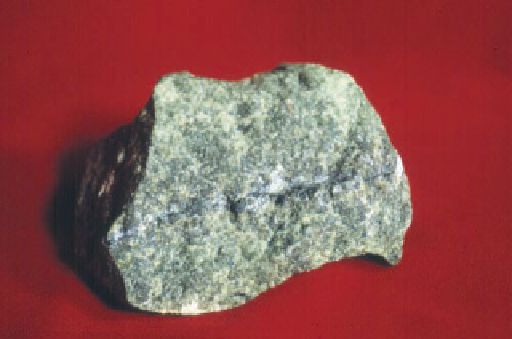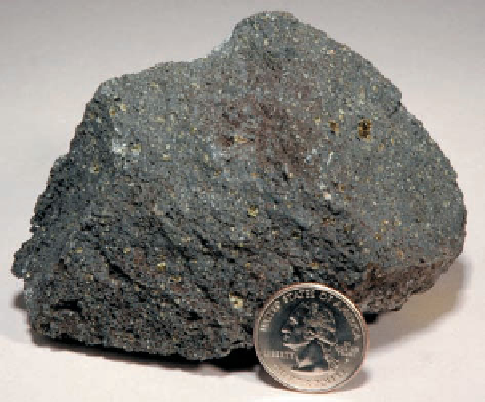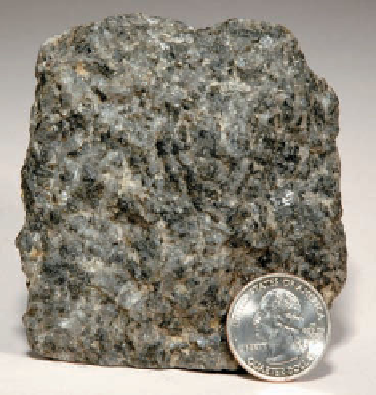Geology Reference
In-Depth Information
Gabbro is much less common than basalt, at least in the
continental crust or where it can be easily observed. Small
intrusive bodies of gabbro are present in the continental
crust, but intermediate to felsic intrusive rocks are much
more common. However, the lower part of the oceanic crust
is composed of gabbro.
Andesite-Diorite
Intermediate-composition magma (53-
65% silica) crystallizes to form
andesite
and
diorite
, which are
compositionally equivalent fi ne- and coarse-grained igneous
rocks (
Figure 4.13). Andesite and diorite are composed pre-
dominately of plagioclase feldspar, with the typical ferromag-
nesian component being amphibole or biotite (Figure 4.10).
Andesite is generally medium to dark gray, but diorite has a
salt-and-pepper appearance because of its white to light gray
plagioclase and dark ferromagnesian silicates (Figure 4.13).
Andesite is a common extrusive igneous rock formed
from lava erupted in volcanic chains at convergent plate
boundaries. The volcanoes of the Andes Mountains of South
America and the Cascade Range in western North America
are composed, in part, of andesite. Intrusive bodies of diorite
are fairly common in the continental crust.
◗
◗
Figure 4.11
Peridotite This specimen of the ultramafi c rock
peridotite is made up mostly of olivine. Notice in Figure 4.10 that
peridotite is the only phaneritic rock that does not have an aphanitic
counterpart. Peridotite is rare at Earth's surface, but is very likely
the rock that makes up the mantle.
hotter than now and ultramafi c lavas could erupt onto the sur-
face. Because the amount of heat has decreased over time, Earth
has cooled, and eruptions of ultramafi c lava fl ows have ceased.
Rhyolite-Granite
Rhyolite
and
granite
crystallize from fel-
sic magma (>65% silica) and are therefore silica-rich rocks
(
Basalt-Gabbro
Basalt
and
gabbro
are the aphanitic and pha-
neritic rocks that crystallize from mafi c magma (45-52% silica)
(
Figure 4.14). They consist mostly of potassium feldspar,
sodium-rich plagioclase, and quartz, with perhaps some biotite
and rarely amphibole (Figure 4.10). Because nonferromagne-
sian silicates predominate, rhyolite and granite are typically light
colored. Rhyolite is fine grained, although most often it con-
tains phenocrysts of potassium feldspar or quartz, and granite is
coarse grained. Granite porphyry is also fairly common.
Rhyolite lava fl ows are much less common than andesite
and basalt fl ows. Recall that one control of magma viscosity is
silica content. Thus, if felsic magma rises to the surface, it be-
gins to cool, the pressure on it decreases, and gases are released
explosively, usually yielding rhyolitic pyroclastic materials.
◗
Figure 4.12). Thus, both have the same composition—mostly
calcium-rich plagioclase and pyroxene, with smaller amounts
of olivine and amphibole (Figure 4.10). Because they contain
a large proportion of ferromagnesian silicates, basalt and
gabbro are dark; those that are porphyritic typically contain
calcium plagioclase or olivine phenocrysts.
Extensive basalt lava fl ows cover vast areas in Washing-
ton, Oregon, Idaho, and northern California (see Chapter 5).
Oceanic islands such as Iceland, the Galápagos, the Azores,
and the Hawaiian Islands are composed mostly of basalt, and
basalt makes up the upper part of the oceanic crust.
◗
Basalt is aphanitic.
b
Gabbro is phaneritic. Notice the light refl ected from
the crystal faces.
a
◗
Figure 4.12
Mafi c Igneous Rocks





Search WWH ::

Custom Search